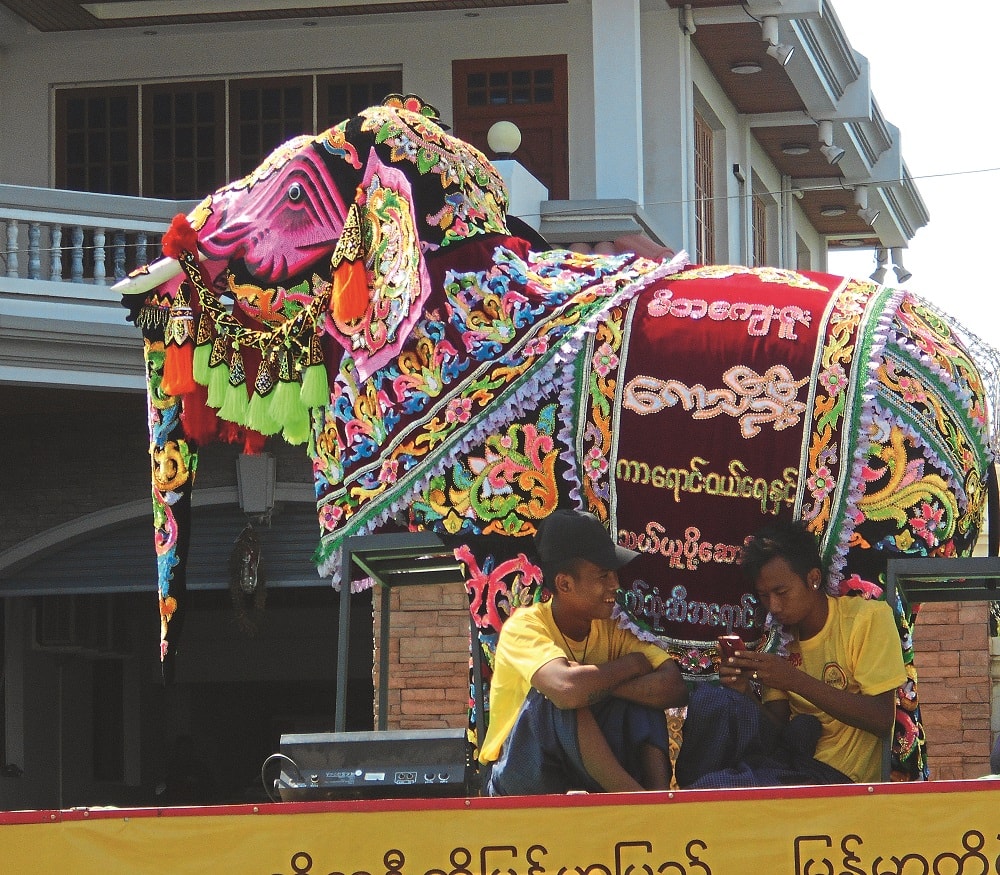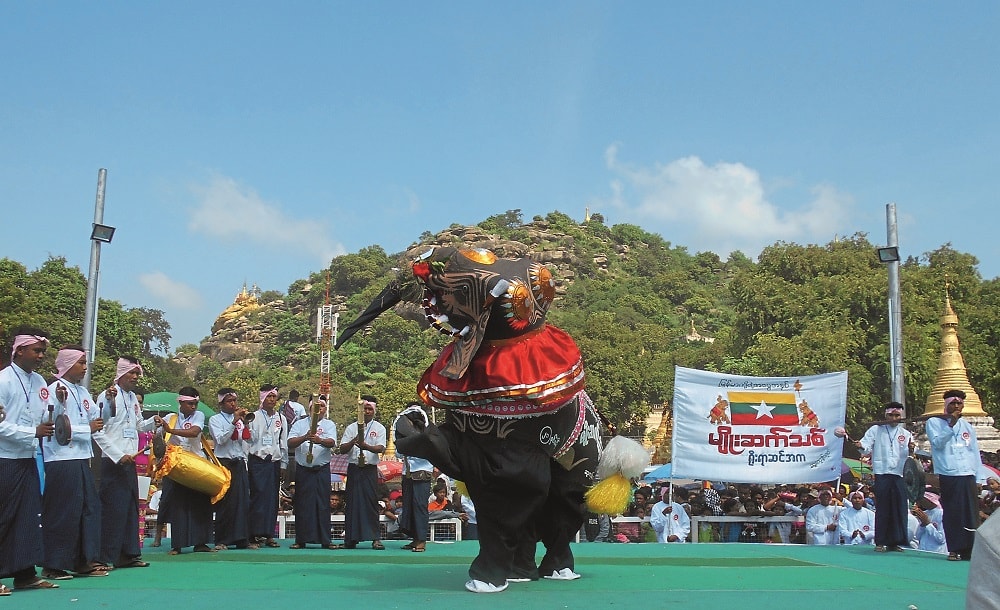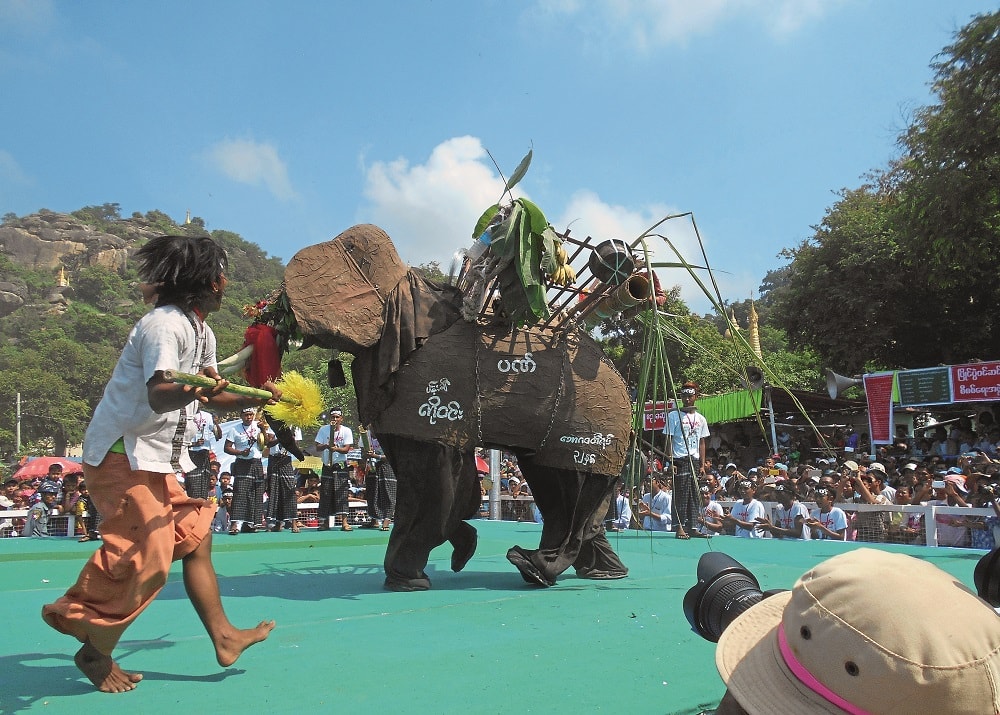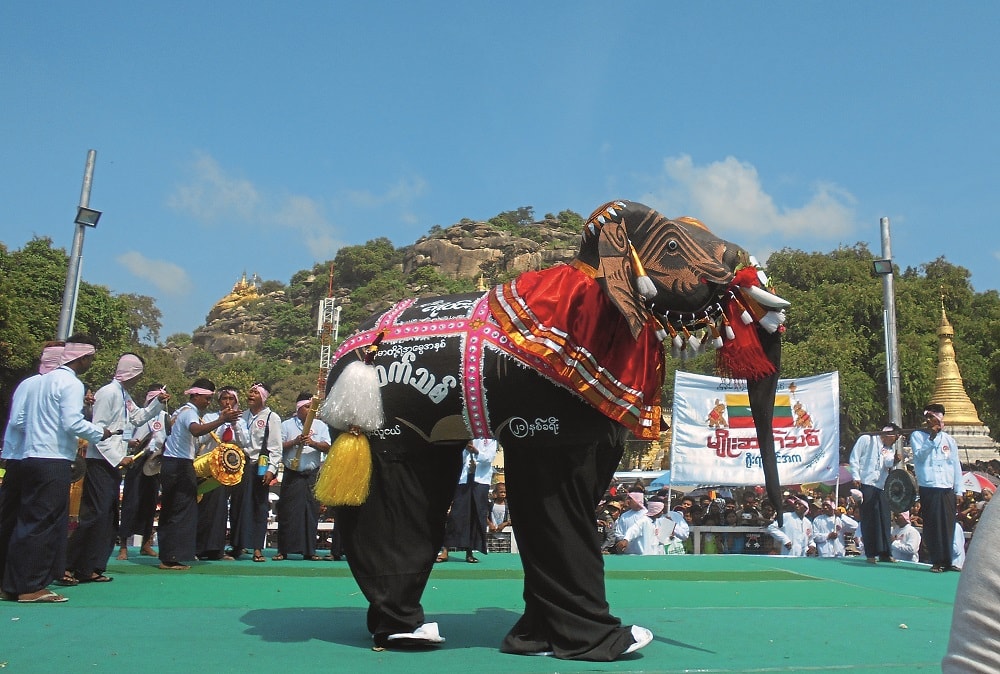Myanmar folk travel to hundreds of festivals every year – but the only elephant festival is at Kyaukse, one hour’s drive from Mandalay. The festival has been held on the day before the full moon of Thadingyut (October) every year since the time of King Anawrahta in the 11th century.
We park the car and follow a mobile band dressed all in white with green headscarves. We try to keep behind them as they make a thin channel in the otherwise burgeoning stream of jostling people who are making their way to the elephant dancing ground. Everyone looks their best. The women are wearing brilliantly coloured longyis, some are striped, others spotted, and some are twinkling with sequins. Food stalls line both sides of the lane selling sweetcorn, peanuts, fruit, cakes, biscuits, and all kinds of fizzy and energising drinks.
We enter the elephant dance floor through a gate guarded by elephants (stone ones). We manage to find places in the tiers of seats under a plastic roof, which will help to shade us or keep us dry if it rains. October is the end of the rainy season – but you never know.
The elephant festival is a dance competition between groups in town and the surrounding villages. But these elephants are not the ivory-tusked variety. They have been made in workshops in Kyaukse for over 100 years. They are constructed of huge bamboo frames covered with papier maché to conceal two men within.

When dancing, one man works the front legs and head and the other the back. The back man has to be strong enough to lift both the elephant and the other man when the elephant prances on its back legs – as elephants are wont to do. The bamboo frame is in two separate parts: the head and the body. And it’s a big body – these elephants are 1.8 metres tall. Poles rest on the men’s shoulders and there are handles to manipulate its movements.
The back-end dancer uses the poles in the body to rear and plunge. Inside the head, the handles can swing in the direction of possible donors – great idea. The elephant’s feet are bamboo frames of suitably sturdy size, covered with material. Once the frame is ready, workers apply layer on layer of papier-maché to round out the chubby contours. They paint or lacquer the body or add fabric in dazzling colours.
Today, real elephants live only in the deepest jungle. They help with teak logging in areas such as Taungoo, but elephants have played an important role in Myanmar since historical times. They carried kings into battle and white elephants were credited with ensuring good rain and increasing crop yields.
Kings of the Ava and Konbaung dynasty adopted the moniker ‘Lord of the White Elephant.’ When King Anawrahta carried a sacred tooth relic from Sri Lanka on an elephant, he noted where the elephant stopped on the summit of hills and had paya (pagodas) built there. One of these is above Kyaukse: the Shwethalyaung Paya. To ensure the populous remembered King Anawrahta – and possibly the elephant too – he made elephant figures and offered themon the full moon day of Thadingyut each year.
Nowadays, on the day before the full moon, all the local people stage elephant dance competitions. There are three categories: Sequined Elephant, Traditional Elephant, and Young Elephant. The dance re-enacts sin uzie (elephant trainers) going into the forest to capture, subdue, and train a wild elephant to take back to the King. The winners of each group will receive several hundred dollars, so these are prizes worth winning.

As the government owns most of the elephants now, they remain largely in forest reserves, though they can be hired for $100 for the ceremony of shin pyu at which all Myanmar boys are inducted into the monastery as part of their religious training. Along with each elephant comes the group’s singer and band, which plays at the only volume Myanmar knows: INCREDIBLY LOUD.
We arrive near the end of the sequined elephant’s performance. Fortunately, so we don’t miss anything, all the turns will enact the same rituals. The sequined elephant stalked regally away, condescendingly bowing to the audience. The band escorted the it off the field. It was then lifted bodily onto its waiting truck and another elephant arrived.
The next elephant is in the category of traditional elephant and it looks (somewhat) as it would appear in the forest. The sin oozie, has hung his kettle and cooking pots down either side of its back. This elephant will be judged not for its luxurious appearance, but from its realistic movements. Its trunk moves up and down as it would in the forest as it begins to stomp along. The band accompanying this performance is keeping the beat with bamboo clappers about two feet long – easily obtainable in the forests around Kyaukse. This elephant has not one but two sin oozie. They are trying to catch him as they always do after he has spent the night in the forest. The elephant is resisting, but not charging or running away. At last the elephant goes down on bent knees and one sin oozie pretends to climb on board.
Mercifully for the two men inside, he is only pretending. The sin oozie then romp around the stage to show how clever they are and the crowd claps its approval. If we don’t clap loud enough or long enough, they mimic handclaps until we do!

The next group of bandsmen enters wearing navy longyis, white shirts, and pink headscarves. This band has a woman singer. Women have been notably absent in other respects in the festival, so it is good to see there is a place for at least one. Doubtless they work hard behind the scenes – as does every woman in Myanmar.
This elephant comes in the young elephant category. It toddles in wearing a shiny red satin shawl around its head, neck, and shoulders. Lots of pink straps extend over its body and its ears flap around limply at every turn. Now the clappers and drums beat delightedly: they are accompanied this time by a trumpet. The young elephant kneels endearingly forward onto its knees and wriggles its large bottom.
The chairman of the band explains the different ways to catch an elephant – which could come in handy should any of us ever need to capture one. This young elephant does not take as long to be caught as the adults. Next, and beloved by the audience, is a very young elephant.We note that the band comprises young students and, unbelievably, the sin oozie is about five years old! Young he may be, but his poise and accomplishments are certainly notable.
Each performance lasts about half an hour and we realize there are many, many more performances still to come. By noon, the sun is beating down remorselessly. We wonder how the groups keep going, but they have to – and we don’t. So at last we leave the Elephant Dancing Festival remembering that tomorrow the elephant groups and all the villagers will climb Shwethalyaung Mountain.
They will donate offerings at the pagoda which, together with the work and the love that has gone into making the elephants and the festival, will help them gain their way to wei nei ya: nirvana.
Judyth Gregory-Smith, nature and travel writer, is the author of Myanmar: a Memoir of Loss and Recovery, Sulawesi: Ujung Pandang to Kendari, and Southeast Sulawesi – Islands of Surprises.
A version of this article was originally published in The Expat magazine (July 2017) which is available online or in print via a free subscription.
"ExpatGo welcomes and encourages comments, input, and divergent opinions. However, we kindly request that you use suitable language in your comments, and refrain from any sort of personal attack, hate speech, or disparaging rhetoric. Comments not in line with this are subject to removal from the site. "



















